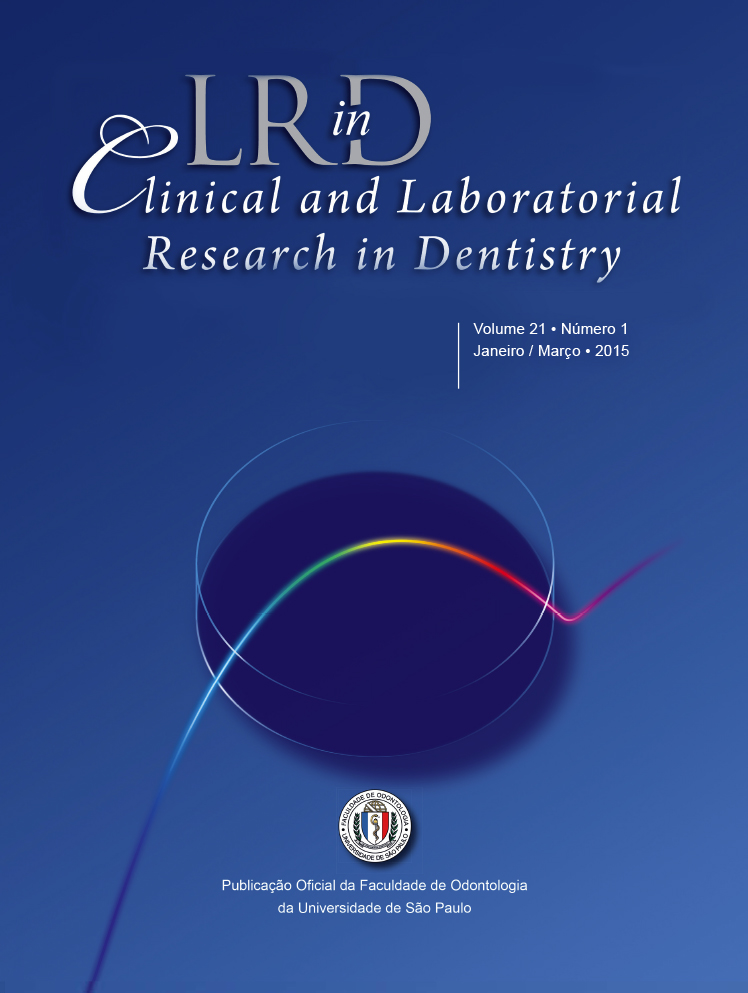The effect of powdered juice on human dental enamel dissolution
DOI:
https://doi.org/10.11606/issn.2357-8041.clrd.2015.97559Keywords:
Dental Enamel, Hydrogen-Ion Concentration, Beverages, Citric AcidAbstract
Aim: The aim of this in vitro study was to evaluate the dissolution potential of an artificial powdered juice in human dental enamel. Methods: Three commercially available beverages were tested by first evaluating the pH and the titratable acidity. After this, 40 enamel specimens were individually immersed in the respective solutions for 120 min (n = 8) as follows: C+: distilled water (positive control); TAN: artificial powdered orange juice; DEL: natural orange juice, CC: Coca-Cola and C-: citric acid solution 1% (negative control). At the end, each solution was analyzed for the amount of calcium (Ca) released and the data obtained were analyzed using ANOVA followed by Tukey test (p <0.05). Results: All solutions had low pH values. The C- group had the highest titratable acidity, followed by DEL, TAN and CC. TAN (0,92)a resulted in a lower release of Ca, being statistically similar to C+ group (0,46)a, while CC (6,32)c resulted in the higher release of calcium, followed by C- (4,17)bc and DEL (3,13)b groups. Relevance: The artificial powdered juice tested, although acid and high titratable acidity caused no enamel dissolution.
Downloads
References
Senna A, Del Bel Cury A, Rosing C. Non-carious cervical lesions and occlusion: a systematic review of clinical studies. J Oral Rehab. 2012 Jun;39(6):450-62.
ten Cate JM, Imfeld T. Dental erosion, summary. Eur J Oral Sci. 1996 Apr;104(2 (Pt 2)):241-4.
Dugmore CR, Rock WP. A multifactorial analysis of factors associated with dental erosion. Br Dent J. 2004 Mar;196(5):283-86.
Sebrae. Consumo de suco cresce no Brasil. Associação Brasileira das Indústrias de Refrigerantes e Bebidas Não Alcóolicas. [Accessed on 2013 Dec 17]. Available from http://gestaoportal.sebrae.com.br/uf/paraiba/produtos-e-servicos/setores-atendidos/fruticultura/consumo-de-suco-cresce-no-brasil/BIA_18283
Corso S, Padilha DMP, Corso AC, Hugo FN. Avaliação do potencial erosivo de sucos de fruta artificiais em pó, refrigerantes, isotônicos e chás enlatados disponíveis comercialmente no Brasil. RFO UPF. 2006 Jan/Jun;11(1):45-50.
Gonçalves GK, Guglielmi CA, Corrêa FN, Raggio DP, Corrêa MS. Erosive potential of different types of grape juices. Braz Oral Res. 2012 Sep-Oct;26(5):457-63.
Featherstone JDB, Lussi A. Understanding the chemistry of dental erosion. Monogr Oral Sci. 2006;20:66-76.
Hara AT, Zero DT. Analysis of the erosive potential of calcium-containing acidic beverages. Eur J Oral Sci. 2008 Feb;116(1):60-5.
Cochrane NJ, Cai F, Yuan Y, Reynolds EC. Erosive potential of beverages sold in Australian schools. Austr. Dent J. 2009 Sep;54(3):238-44.
Lussi A, Jaeggi T, Zero D. The role of diet in the aetiology of dental erosion. Caries Res. 2004;38(Suppl 1):34-44.
Lussi A, Jaggi T, Scharer S. The influence of different factors on in vitro enamel erosion. Caries Res. 1993; 27(5): 387–93.
Larsen MJ, Nyvad B. Enamel erosion by some soft drinks and orange juices relative to their pH, buffering effect and contents of calcium phosphate. Caries Res. 1999;33(1):81-7.
Edwards M, Creanor SL, Foye RH, Gilmour WH. Buffering capacities of soft drinks: the potential influence on dental erosion. J Oral Rehabil. 1999 Dec; 26(12):923–27.
Furtado JR, Freire VC, Messias DCF, Turssi CP. Aspectos físico-químicos relacionados ao potencial erosivo de bebidas ácidas. RFO UPF. 2010 Sept/Dez;15(3):325-30.
Ehlen LA, Marshall TA, Qian F, Wefel JS, Warren JJ. Acidic beverages increase the risk of in vitro tooth erosion. Nutr Res. 2008 May;28(5):299-303.
Lussi A, Jaeggi T. Chemical Factors. Monogr Oral Sci. 2006;20:77-87.
Barbour ME, Rees GD. The role of erosion, abrasion and attrition in tooth wear. J Clin Dent. 2006;17(4):88-93.
Zero DT, Lussi A. Erosion-chemical and biological factors of importance to the dental practitioner. Int Dent J. 2005;55(4 Suppl 1):285-90.
Jensdottir T, Bardow A, Holbrook P. Properties and modification of soft drinks in relation to their erosive potential in vitro. J Dent. 2005 Aug;33(7):569-75.
Meurman JH, Rytomaa I, Kari K, Laakso T, Murtomaa H. Salivary pH and glucose after consuming various beverages including sugar-containing drinks. Caries Res. 1987;21(4):353-59.
Downloads
Published
Issue
Section
License
Authors are requested to send, together with the letter to the Editors, a term of responsibility. Thus, the works submitted for appreciation for publication must be accompanied by a document containing the signature of each of the authors, the model of which is presented as follows:
I/We, _________________________, author(s) of the work entitled_______________, now submitted for the appreciation of Clinical and Laboratorial Research in Dentistry, agree that the authors retain copyright and grant the journal right of first publication with the work simultaneously licensed under a Creative Commons Attribution License that allows others to share the work with an acknowledgement of the work's authorship and initial publication in this journal. Authors are able to enter into separate, additional contractual arrangements for the non-exclusive distribution of the journal's published version of the work (e.g., post it to an institutional repository or publish it in a book), with an acknowledgement of its initial publication in this journal. Authors are permitted and encouraged to post their work online (e.g., in institutional repositories or on their website) prior to and during the submission process, as it can lead to productive exchanges, as well as earlier and greater citation of published work (See The Effect of Open Access).
Date: ____/____/____Signature(s): _______________


